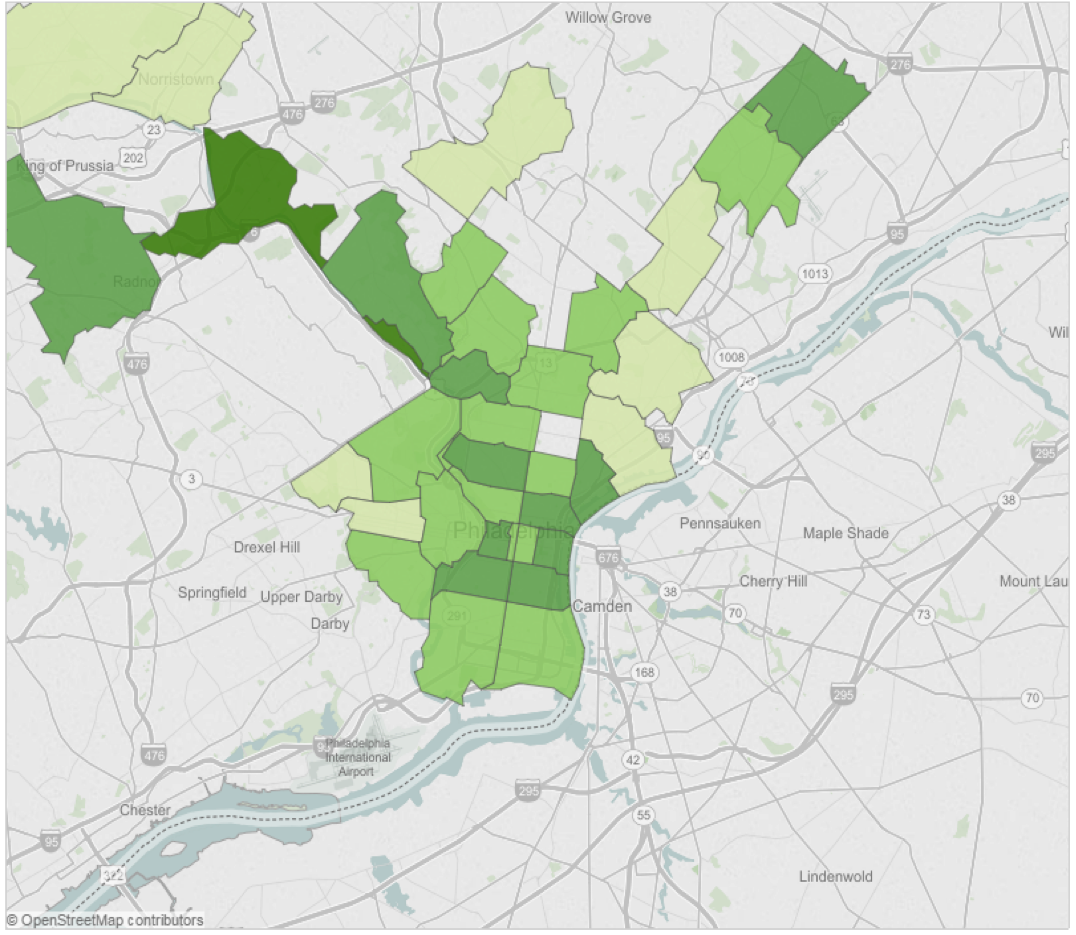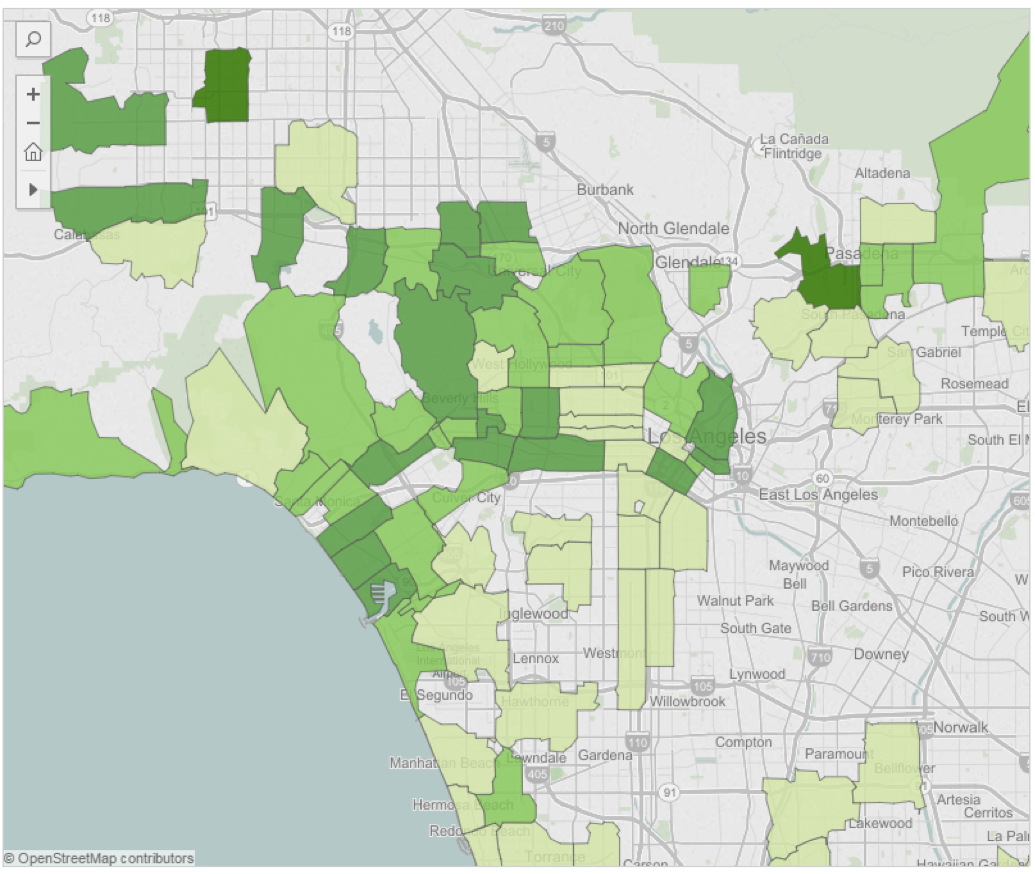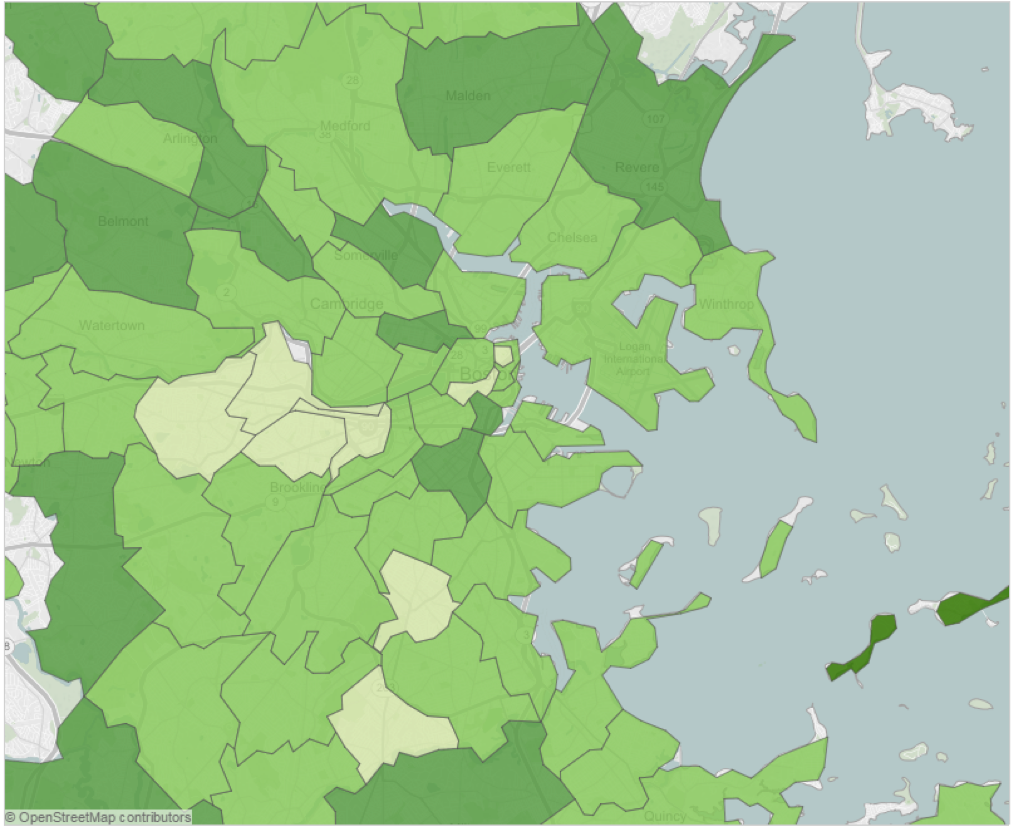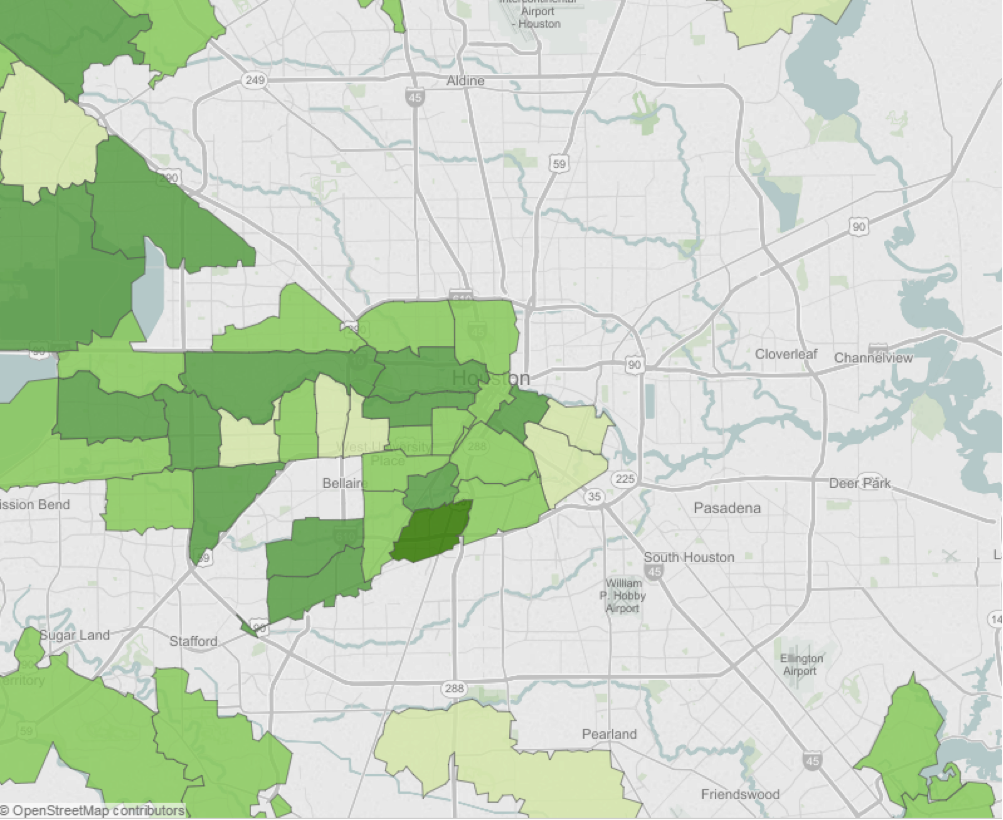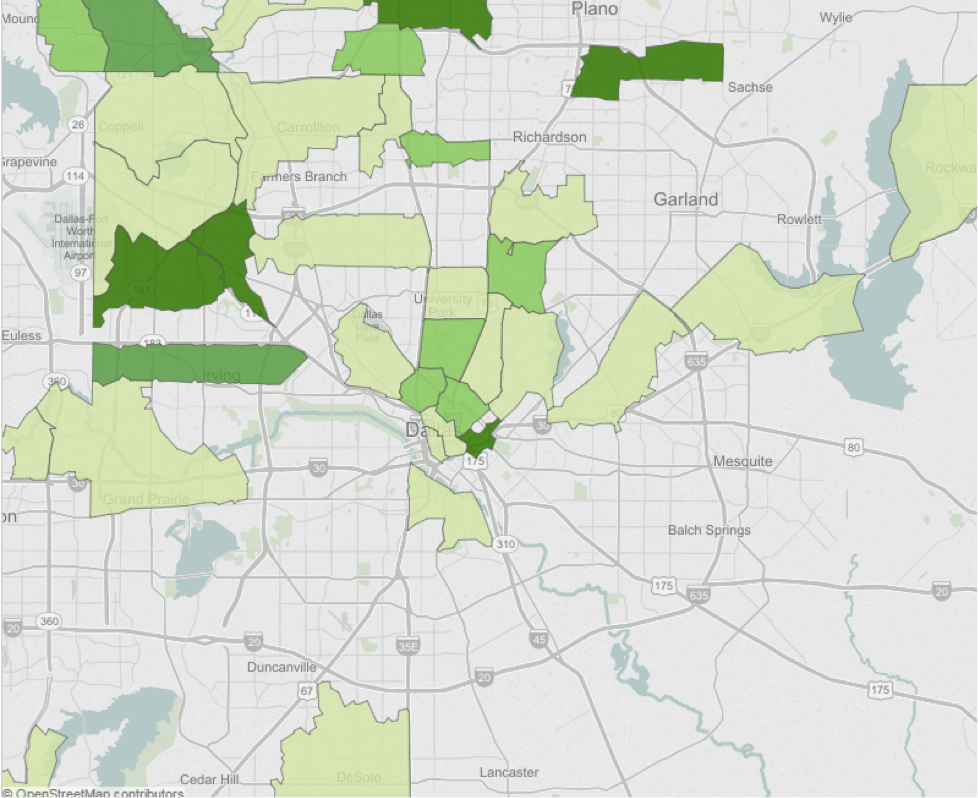Summer is coming. But instead of spending the endless days of the season lounging by a pool, many renters will inevitably spend a portion of their days hauling laundry down the block or across town to their local Laundromat.
Here at Trulia, we (and your landlord) know that having an in-unit washer and dryer is a coveted amenity that often ranks high on renters’ list of must-haves. But just how much extra in rent are you likely to pay each month to not have to collect quarters or haul your skivvies down the street for the world to see?
Trulia took a spin through the large multi-family buildings listed for rent on its site and found that across 13 top metro areas, in-unit washers and dryers command a 10% per month premium on average.
Those living in Philadelphia pay the biggest premium for in-unit laundry to the tune of 20%, or $211 extra in monthly rent. Those living in Seattle pay 4%, about $29 more in rent each month to avoid having to brave the rain with their laundry baskets in tow.
 <
<
| Where Renters Must Pay The Highest Premiums for an In-Unit Washer Dryer * | |||||
| U.S. Metro(click on hyperlinks below to access interactive neighborhood maps) | Average % Rent Premium | Average $ Rent Premium | % of Multifamily Rentals Listed as Having a Washer / Dryer | Median Year Built | Median Rent |
| Philadelphia | 20% | $211 | 48% | 1965 | $1200 |
| Los Angeles | 17% | $325 | 26% | 1987 | $2095 |
| San Francisco | 14% | $245 | 35% | 1979 | $2620 |
| Boston | 14% | $255 | 36% | 1956 | $2000 |
| Chicago | 11% | $168 | 56% | 2001 | $1796 |
| New York | 10% | $175 | 20% | 1958 | $2100 |
| Houston | 9% | $139 | 36% | 2001 | $1450 |
| Washington | 8% | $133 | 58% | 1996 | $1750 |
| San Diego | 8% | $118 | 37% | 1986 | $1750 |
| Atlanta | 7% | $73 | 33% | 2000 | $1200 |
| Miami-Fort Lauderdale | 5% | $79 | 42% | 1990 | $1650 |
| Seattle | 4% | $29 | 41% | 1994 | $1495 |
| Dallas-Fort Worth | 3% | $33 | 26% | 2002 | $1200 |
| *Please note that the washer/dryer premium in this study refers to the premium one must pay in order to live in an apartment that has a private washer/dryer within the unit. This premium does not apply to units that do not have a washer/dryer in-unit but do have communal washers/dryers on building premises. | |||||
The Down and Dirty On Laundry Costs
Anyone who has rented an apartment without laundry knows that it takes time, energy and a lot of quarters to get your clothes clean. Even if there are Laundromats within walking distance of your apartment, carrying 10lbs of laundry can be burdensome.
In large cities, wash and folds (places that do your laundry for you) cost around $1.00 per pound of laundry. Assuming that you do 10lbs of laundry per week, you will spend $40 per month. If you opt for cheaper, coin-operated machines, at $3 a load you’ll pay a least $12 a month.
If you live in Seattle or Dallas-Fort Worth, renters could be better off renting a unit with a washer and dryer because the costs of doing laundry offsite are similar to the washer/dryer premium in those metros. In the other metros listed, however, you’ll pay anywhere from $73 to $325 extra, so renters on a budget will have to weigh the inconvenience of having to go to the Laundromat over the cost savings.
Sprawled out metros such as Philadelphia and Los Angeles likely have a greater washer/ dryer premium, because the distance from most apartments to the nearest Laundromats will be farther away. Metros where the cost of goods is more expensive also have high premiums on laundering, such as San Francisco, Boston and New York with higher cost of living.
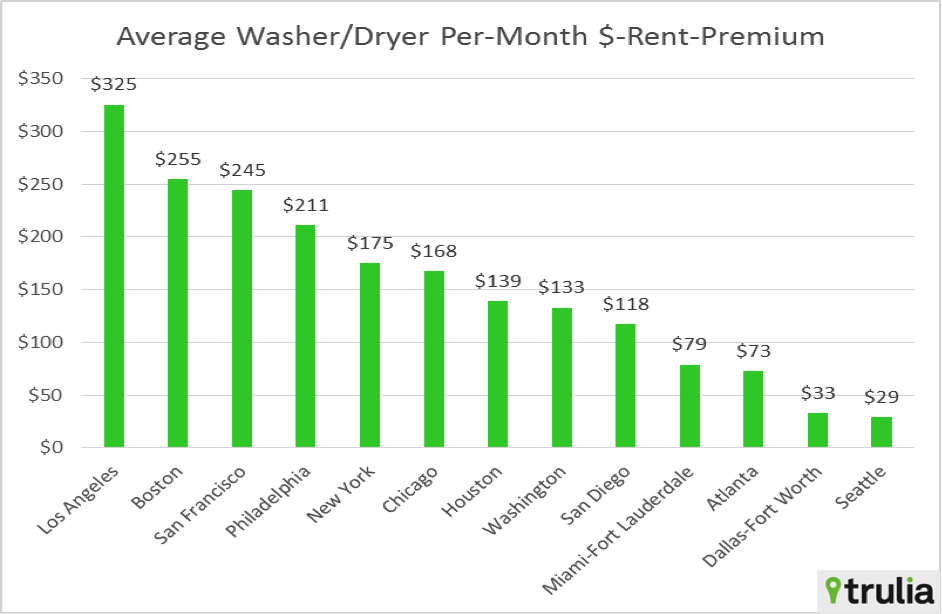

Washer/Dryer a Must-Have Amenity? Start The Search Cycle In these Suds-Friendly Neighborhoods
Have you decided that having laundry in your apartment is worth the added premium? Below are some helpful maps showing renters which ZIP codes have the highest percentage (shown in dark green) and lowest percentage (shown in light green) of large apartment buildings with washer and dryers in-unit. Click on the maps to be taken to an interactive city map showing where you’ll find the highest percent of in-unit apartment washers and dryers.
Neighborhoods with the highest % of in-unit washer/dryer: Conshohocken, Manayunk, Northern Liberties, Callowhill
Neighborhoods with the lowest % of in-unit washer/dryer: Overbrook Farms, Millbourne, Walnut Hill
Neighborhoods with highest % of in-unit washer/dryer: Santa Monica, Pasadena, Studio City, Little Tokyo, Skid Row, Arts District
Neighborhoods with lowest % of in-unit washer/dryer: Woodland Hills, View Park–Windsor Hills, Wilshire Center, Koreatown
Neighborhoods with the highest % of in-unit washer/dryer: Inner Richmond, Laurel Heights, Lone Mountain, South Beach
Neighborhoods with the lowest % of in-unit washer/dryer: Twin Peaks, Diamond Heights, Glen Park
Neighborhoods with highest % of in-unit washer/dryer: Downtown, South End, Mission Hill, South Boston
Neighborhoods with lowest % of in-unit washer/dryer: Fenway/Kenmore, Allston/Brighton, Roxbury, Dorchester, Mattapan
Neighborhoods with the highest % of in-unit washer/dryer: West Loop Gate, The Loop, River North, South Loop
Neighborhoods with the lowest % of in-unit washer/dryer: Roseland, South Chicago, South Austin, Garfield Park
Neighborhoods with the highest % of in-unit washer/dryer: Midtown West, Lenox Hill, Tribeca, Hudson Square, SoHo
Neighborhoods with the lowest % of in-unit washer/dryer: Greenwich Village, West Village, Midtown East
Neighborhoods with the highest % of in-unit washer/dryer: South Main, River Oaks, Fourth Ward, Westbury, Willow Meadows
Neighborhoods with the lowest % of in-unit washer/dryer: Gulfgate-Pine Valley, Greater East End, Magnolia Park, Afton Oaks
Neighborhoods with the highest % of in-unit washer/dryer: Shaw, LeDroit Park, Capitol Hill, Arlington – Clarendon
Neighborhoods with the lowest % of in-unit washer/dryer: Southwest Waterfront, Fort Dupont, Shepherd Park
Neighborhoods with the highest % of in-unit washer/dryer: Scripps Ranch, Mission Valley, Mission Valley East, Torrey Highlands, Rancho Pentasquitos
Neighborhoods with the lowest % of in-unit washer/dryer: Barrio Logan, Kensington, Normal Heights, University Heights, El Cajon
Neighborhoods with the highest % of in-unit washer/dryer: NorthLake, Sandy Springs, Lindridge-Martin Manor, Lindbergh
Neighborhoods with the lowest % of in-unit washer/dryer: Redan, Lithonia, Union City, Atlanta University area
Neighborhoods with the highest % of in-unit washer/dryer: Downtown, Dodge Island, Virginia Key, Upper East Side, Morningside, Edgewater
Neighborhoods with the lowest % of in-unit washer/dryer: Brownsville, Allapatttah, Coral Way, Miami Shores, El Portal
Neighborhoods with the highest % of in-unit washer/dryer: Woodinville, Cottage Lake, Kingsgate, Totem Lake
Neighborhoods with the lowest % of in-unit washer/dryer: Canyon Park, Pioneer Square, West Lake, South West Union
Neighborhoods with the highest % of in-unit washer/dryer: Los Colinas, Broadmoor Hills, Deep Ellum, Castlemere, Willow Bend, Breckenridge Park
Neighborhoods with the lowest % of in-unit washer/dryer: Southwestern District, Grand Prairie, University Park, Downtown
Methodology
Data is sourced from the Zillow Group rental listing database. We looked just at units in multi-family apartment buildings for rent between September 2014 and February 2015. For each metro area, the listings were split into quartiles based on the age of the building. We then took the difference between the median rent of apartments that have a washer/dryer and apartments that do not have a washer/dryer in order to obtain the ($) premium for each quartile. We averaged these ($) premium figures in order to obtain the average ($) premium for each metro.

